
The Patria Pasi is a Finnish-made six-wheeled armoured personnel carrier (APC) originally designed for Finnish Defence Forces. The first variant was produced in 1983 and serial production began in 1984. It was designed to operate with ease of use, simple structure and low-cost maintenance. The basic appearance and configuration of the Pasi is similar to most other wheeled APCs. The XA-180 and XA-185 are fully amphibious while other variants are not.

The Mowag Piranha is a family of armoured fighting vehicles designed by the Swiss company Mowag.

The Mamba is a South African armoured personnel carrier designed for internal security purposes. It was developed during the late 1980s to replace the Buffel in service with the South African military and security forces. The first models were built on a 4X2 Toyota Dyna chassis, which was subsequently replaced in production around 1994 by a more reliable Unimog chassis. All marks of the Mamba were designed to be mine-resistant and blastproof.

The Véhicule de l'Avant Blindé or VAB is a French armoured personnel carrier and support vehicle designed and manufactured by Renault Trucks Defense. It entered French service in 1979 and around 5,000 were produced for the French Army as well as for export. It has seen combat in various conflicts in Africa, Asia as well as Europe and has also been exported to more than 15 countries.
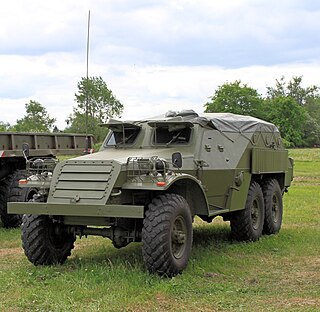
The BTR-152 is a six-wheeled Soviet armored personnel carrier (APC) built on the chassis and drive train of a ZIS-151 utility truck. It entered service with a number of Warsaw Pact member states beginning in 1950, and formed the mainstay of Soviet motor rifle battalions until the advent of the amphibious BTR-60 series during the 1960s. BTR stands for bronetransportyor.
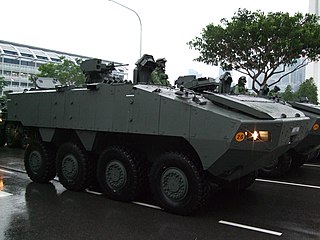
The Terrex Infantry Carrier Vehicle (ICV) is an armoured fighting vehicle (AFV) developed by ST Engineering of Singapore and Timoney Technology of Ireland, and produced by ST Engineering Land Systems for the Singapore Army as well as by Turkish auto-maker Otokar as the Yavuz (AV-82) for the Turkish military.
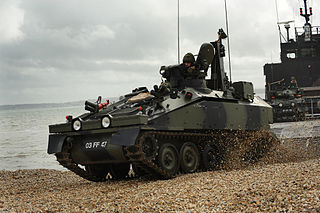
FV103 Spartan is a tracked armoured personnel carrier. It was developed for the British Army as the APC variant of the Combat Vehicle Reconnaissance (Tracked) family. The vehicle can carry up to seven personnel, including three crew members. Armed with a single machine gun, it is almost indistinguishable from the FV102 Striker in external appearance.
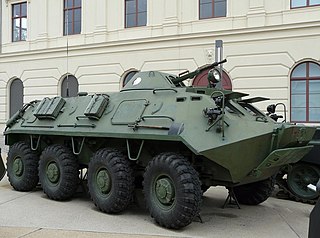
The BTR-60 is the first vehicle in a series of Soviet eight-wheeled armoured personnel carriers (APCs). It was developed in the late 1950s as a replacement for the BTR-152 and was seen in public for the first time in 1961. BTR stands for bronetransportyor.

The FV603 Saracen is a six-wheeled armoured personnel carrier designed and produced by Alvis from 1952 to 1976. It has been used by a variety of operators around the world and is still in use in secondary roles in some countries. The Saracen became a recognisable vehicle as a result of its part in Operation Banner in Northern Ireland as well as for its role in the South African government's enforcement of apartheid.

The Ferret armoured car, also commonly called the Ferret scout car, is a British armoured fighting vehicle designed and built for reconnaissance purposes. The Ferret was produced between 1952 and 1971 by the UK company Daimler. It was widely used by regiments in the British Army, as well as the RAF Regiment and Commonwealth countries throughout the period.

The FV601 Saladin is a six-wheeled armoured car developed by Crossley Motors and later manufactured by Alvis. Designed in 1954, it replaced the AEC Armoured Car in service with the British Army from 1958 onward. The vehicle weighed 11 tonnes, offered a top speed of 72 km/h, and had a crew of three. Saladins were noted for their excellent performance in desert conditions, and found favour with a number of Middle Eastern armies accordingly. They were armed with a 76 mm low-pressure rifled gun which fired the same ammunition as that mounted on the FV101 Scorpion.

The BTR-80 is an 8×8 wheeled amphibious armoured personnel carrier (APC) designed in the Soviet Union. It was adopted in 1985 and replaced the previous vehicles, the BTR-60 and BTR-70, in the Soviet Army. It was first deployed during the Soviet–Afghan War.

The Simba is a wheeled armoured personnel carrier designed by GKN Sankey. and is currently in service with the Philippine Army.

The Alvis Tactica is a 4x4 or 6x6 wheeled military vehicle produced by GKN Defense, Alvis plc and later by BAE Systems Land Systems. The vehicle was designed by Glover Webb and introduced in 1988. It comes in a number of variants including APC and Internal Security and Riot Control. The platform is no longer produced by BAE Systems.

The Pars is an amphibious armoured combat vehicle family with 4x4, 6×6 and 8×8 versions, produced by FNSS Defence Systems of Turkey.

The WZ-523 is a six-wheeled Chinese armored personnel carrier designed to be amphibious. Built on the chassis of the Hanyang HY472 truck, it can carry a crew of three and seat up to eight additional passengers. Two primary models were produced—one with a roof-mounted 12.7mm heavy machine gun, and the other with a small turret armed with a 35mm grenade launcher and a 7.62mm co-axial general purpose machine gun. An export model that entered service in 2008 as a fire support vehicle was also marketed successfully to the Namibian Army; this is armed with a 73mm 2A28 Grom smoothbore cannon using the same turret as the Soviet BMP-1 infantry fighting vehicle.
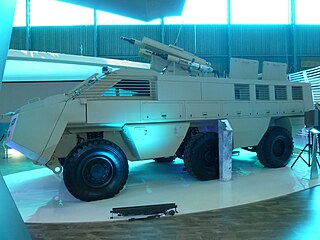
The Mbombe 6 is a mine-protected, high-mobility armoured fighting vehicle produced by Paramount Group from South Africa that was launched in 2010. "Mbombe" is named after an African warrior.

The Tigr is a Russian 4×4 multipurpose all-terrain infantry mobility vehicle manufactured by Military Industrial Company, first delivered to the Russian Army in 2006.

The CS/VP3 MRAP also known as the CS/VP3 Bigfoot is a MRAP developed by Poly Technologies and manufactured by Changan Automobile in China. It was unveiled in China at the China International Aviation & Aerospace Exhibition 2012 in Zhuhai, China, and overseas at the 2012 DSA defense exhibition in Kuala Lumpur, Malaysia.






















